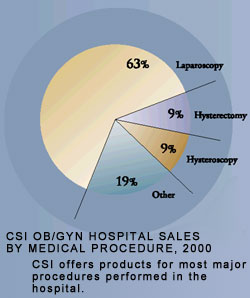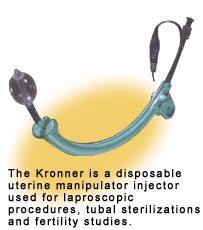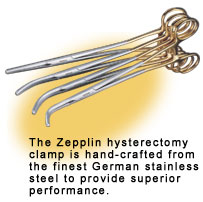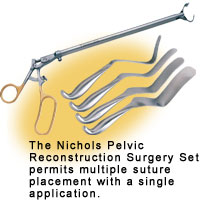|
|
 CSI derives 38 percent of its Ob/Gyn revenue from hospital-based products, primarily from three major procedure areas: laparoscopy, hysteroscopy and hysterectomy. Because office-based practitioners are primarily responsible for specifying which products will be used when these procedures are performed in the hospital, CSI presents its products for hospital use to physicians when calling in their offices. Diagnostic Laparoscopy: Diagnostic laparoscopy is a minimally invasive procedure used in both the hospital and the outpatient clinic to diagnose many gynecologic conditions. The standard equipment used includes a laparoscope, light source, camera with monitor, a device to aid in visualization of the pelvic cavity and a variety of laparoscopic surgical instruments. In addition, laparoscopic surgery on women who have not had a hysterectomy requires a uterine manipulator to improve access and visualization within the pelvic cavity.  CSI
developed a strong presence in the United States disposable uterine manipulation
market when it acquired the Kronner Manipujector and ZUMI products.
These disposables aid in manipulation of the uterus and permit dye injection
to test fallopian tube patency. In addition, for added control, CSI offers
RUMI, a uterine control device that incorporates a reusable handle
with disposable tips. CSI
developed a strong presence in the United States disposable uterine manipulation
market when it acquired the Kronner Manipujector and ZUMI products.
These disposables aid in manipulation of the uterus and permit dye injection
to test fallopian tube patency. In addition, for added control, CSI offers
RUMI, a uterine control device that incorporates a reusable handle
with disposable tips. Operative Laparoscopy: The techniques and indications for laparoscopic surgery continue to evolve. In all cases, skill, training and experience are needed to achieve outcomes equivalent to those in more invasive "open" procedures. There are several well-defined laparoscopic indications in gynecology including sterilization, management of ectopic pregnancy, removal of benign ovarian masses and reduction of uterine tumors. Advanced procedures require specific instrumentation to improve access and duplicate the conditions of an open procedure. CSI's KOH Colpotomizer System facilitates laparoscopic hysterectomy. This patented system that includes disposables, improves anatomical landmarks for the physician, which accelerates the procedure and improves safety. Experienced clinicians have demonstrated similar operative times to open procedures using this system. As with diagnostic laparoscopy, all operative procedures where a uterus is present require a uterine manipulator. With its premier product line, including the Kronner Manipujector, CSI is a leading supplier of disposable uterine manipulators. CSI also provides Nu-Tip, a range of popular laparoscopic instruments with reusable handles for added durability and stability, and disposable tip assemblies for rapid instrument turnaround and consistent performance. The laparoscopic line includes a patented disposable access trocar and the Marlow Balloon Cannula, which improves the surgeon's control and reduces patient trauma. Hospital-Based Gynecologic Procedures
 Diagnostic
Hysteroscopy: Although clinicians can perform diagnostic hysteroscopy
in the office, it is done more often in the hospital or outpatient clinic
where equipment is readily available. CSI's Hyskon is routinely used
as the distension media for diagnostic procedures in the hospital setting.
Diagnostic
Hysteroscopy: Although clinicians can perform diagnostic hysteroscopy
in the office, it is done more often in the hospital or outpatient clinic
where equipment is readily available. CSI's Hyskon is routinely used
as the distension media for diagnostic procedures in the hospital setting.
Hysterectomy: Hysterectomy, the second most frequent surgical procedure in women of reproductive age, is often performed to treat menstrual disorders. Always carried out in a hospital, the surgical approaches are: abdominal, vaginal and laparoscopic with about 75 percent done through an abdominal incision, 25 percent vaginally and a negligible number laparoscopically11. Surgeons perceive CSI's Zeppelin hysterectomy products as the premier instrument line for abdominal procedures.  Pelvic Repair: The main causes of pelvic
support problems are childbirth and aging. The physical stress of childbirth
can cause irreversible tissue and ligament damage. With the onset of menopause,
the loss of estrogen further complicates this. Symptoms range from a feeling
of fullness or heaviness in the bladder to urinary incontinence. Pelvic Repair: The main causes of pelvic
support problems are childbirth and aging. The physical stress of childbirth
can cause irreversible tissue and ligament damage. With the onset of menopause,
the loss of estrogen further complicates this. Symptoms range from a feeling
of fullness or heaviness in the bladder to urinary incontinence. Treatment, depending on the cause and severity, includes HRT, vaginal hysterectomy and advanced pelvic support surgery where the surgeon reconstructs critical ligaments. CSI's Nichols Pelvic Reconstructive Surgery Set is used here. Incontinence surgery has increased in recent years as the population ages. |
||||||||||||||||||||
|
|
||||||